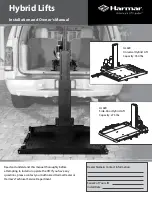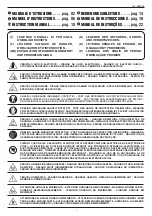
15
3. Verify that the Fork Pockets are securely installed. The Tri-Screws located on the bottom of the forks should be facing
downward.
4.
To transport, insert the blades of the forklift through the Fork Pockets. Raise the forklift blades to the top of the Fork
Pocket tubes.
;
When using the Fork Pockets, always approach from the front of the Jib Boom.
;
Use caution when inserting the blades of the forklift through the Fork Pockets. Moving parts may create pinch
points and cause injury.
6. Tighten the Tri-Screws (A) at the base of each Fork Pocket tube to secure each tube to the forklift blades.
7. Verify that the Jib Boom is secured by its Fork Pockets to the forklift. Secure the Fork Pockets to the forklift by
attaching a Chain (A) from each Fork Pocket Connection Ring (B) to the forklift.
4.0 USE
4.1 BEFORE EACH USE:
Verify that your work area and Fall Protection system meet all criteria defined in these instructions.
Verify that a formal Rescue Plan is in place. Inspect the system per the ‘
User
’ inspection points defined in the “
Inspection
and Maintenance Log
” (Table 2). If inspection reveals an unsafe or defective condition, or if there is any doubt about its
condition for safe use, remove the system from service immediately. Clearly tag the system “DO NOT USE”. See Section 5
for more information.
4.2 SAFE WORKING RADIUS:
The Safe Working Radius of the Jib Boom does not extend beyond the length of the Jib
Boom itself. See Figure 11.3 for reference. When using the M100 Jib System, the user should remain within the indicated
Safe Working Zone (A). Leaving the Safe Working Zone to an Outside Location (B) is dangerous and could result in
serious injury or death. When working on either side of the M100 Jib System, keep the anchor point as close overhead as
possible. If a rotation stop is in place on the jib mount, never work past that rotation stop.
5.0 INSPECTION
;
After product has been removed from service, it may not be returned to service until a Competent Person confirms
in writing that it is acceptable to do so.
5.1 INSPECTION FREQUENCY:
The product shall be inspected before each use by the user and, additionally, by a
Competent Person other than the user at intervals of no longer than one year. A higher frequency of equipment use
and harsher conditions may require increasing the frequency of Competent Person inspections. The frequency of these
inspections should be determined by the Competent Person per the specific conditions of the worksite.
5.2 INSPECTION PROCEDURES:
Inspect this product per the procedures listed in the
“Inspection and Maintenance Log”
.
Documentation of each inspection should be maintained by the owner of this equipment. An inspection and maintenance
log should be placed near the product or be otherwise easily accessible to users. It is recommended that the product is
marked with the date of next or last inspection.
5.3 DEFECTS:
If the Jib Boom cannot be returned to service because of an existing defect or unsafe condition, then either
destroy the system or contact 3M or a 3M-authorized service center about possible repair.
5.4 PRODUCT LIFE:
The functional life of the Jib Boom is determined by work conditions and maintenance. As long as the
product passes inspection criteria, it may remain in service.
6.0 MAINTENANCE, SERVICE, and STORAGE
6.1 CLEANING:
Periodically clean the metal components of the Jib Boom with a soft brush, warm water, and a mild soap
solution. Ensure parts are thoroughly rinsed with clean water.
6.2 SERVICE:
Only 3M or parties authorized in writing by 3M may make repairs to this equipment.
6.3 STORAGE:
If applicable, store the Jib Boom and associated Fall Protection equipment in a cool, dry, clean environment
out of direct sunlight. Avoid areas where chemical vapors may exist. Thoroughly inspect components after extended
storage.
;
Some Jib Base models used with the M100 Jib System are permanent. The Jib Boom may be removed from these
Jib Bases for storage or transport, but the Jib Base will have to remain.
7.0 LABELS
and MARKINGS
7.1 LABELS:
Figures 13 and 14 illustrate labels present on the Jib Boom. Figure 13 illustrates label locations and Figure
14 displays those associated labels. Labels must be replaced if they are not present or are not fully legible. Information
provided on each label is as follows:
A
A) 3M Logo B) Applicable Standards C) Read all instructions.
D) Jib Boom Model Numbers and Weight Values
E) Maximum Arresting Force 1,350 lbf (6 kN)
F) Maximum Capacity - One user with a combined weight (clothing, tools, etc.) of no more than 310 lb. (140 kg).
B
A) Manufactured (Year/Month) B) Model Number C) Serial Number
C
A) Engage the Locking Pin to prevent rotation of the system.
B) Disengage the Locking Pin to enable full rotation of the system.
C) Maximum System Rotation is equivalent to the limits allowed by engagement or disengagement of the pin.
D
A) 3M Logo
Summary of Contents for 8530873
Page 2: ...2 2 A B C D E G H J K F G I K H H K K A M F C D E L L N N N N 3 4 A ...
Page 3: ...3 5 6 A B C D E F G A B C 7 A A A A A B A 1 2 3 4 ...
Page 4: ...4 7 C A B 360 A A A B X 0 5 6 ...
Page 5: ...5 8 B A B A B C H R L X X 1 2 3 ...
Page 6: ...6 9 A B A 10 B A A B C C B A A A 1 2 3 1 2 3 4 5 ...
Page 7: ...7 10 A B x2 11 A B 1 6 ...
Page 8: ...8 11 A B A B 12 A 1 3 A 3 1 2 2 A B A B 2 3 ...
Page 37: ...2 2 A 4 000 psi 30 MPa 0 69 yd3 0 53 m3 A C A B x2 3 A B 8530914 C C 1 2 ...
Page 38: ...3 4 A B D C C D 236 x C A B D C 0 D 5 A A ...
Page 40: ...5 7 x 8 4x 1 1 2 ...
Page 41: ...6 9 x x A B A B 10 A B ...
Page 51: ...2 ...
Page 54: ...5 3 4 6 A B A ...
Page 64: ...2 2 A D E C 3 B ...
Page 65: ...3 4 5 6 ...
Page 66: ...4 7 0 8 x 1 A B ...
Page 76: ...2 2 8530885 8530905 1 1 2 2 3 3 B A A B B B A A B A A B C C X 2 5 cm B B B B ...
















































